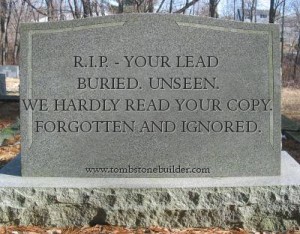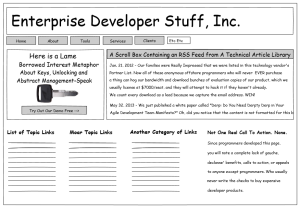 Is Your Product or Benefit Hiding in Plain Sight?
Is Your Product or Benefit Hiding in Plain Sight?
Can someone look at your messaging and almost instantly understand what you do, what you mean, and how you can help them?
If not, you may be burying the lead.
To write effective copy, you need some skills, of course. But you also really need to have a fundamental understanding of how your marketing needs to work. Marketing copy requires a completely different structure and viewpoint than a college essay or management report.
What is a Lead (Lede)? It’s “The Takeaway”
A lead-in (or lede-in, as journalists would spell it) is the introduction to an article or story. A lead (or lead-in) is the headline plus the first passage of the following text.
The lead, or lead-in, is the stuff that convinces a visitor to hang around and read something.
A headline that triggers reader interest is very important. It triggers interest that invites a visitor to start reading the following article or story. The following words help the visitor decide if they want to commit to reading your piece. Or not.
If it helps you understand the issue, then reframe the idea of a lead as the “takeaway” – the main idea in a piece of writing.
A Real Life Example of Lead Burial (Well, the Exaggerated Version)
Here is my rendition of the web site for an enterprise product/service that I saw recently:
(Click on the reduced image above to see my sarcastic parody of the copy that this place is using.)
I found, in researching this company’s product on the web, that their sponsored pay per click (PPC) ad simply directs to this home page.
I screamed inwardly at this point.
The company owner is proud of the efficient and clever use of an RSS feed from their content library, which provides the excerpts that scroll by in the window.
The “only” problem with this ingenuity is that almost nothing that scrolls by in the window is relevant to a first time web visitor.
Where Is the Lead?
Anything resembling a lead is buried by two different factors: the presentation of the home page; and the lead containing material itself.
In a way, it’s a double-whammy – the lead is hard to find and hard to read once you find it.
The real story about the product – which whoever wrote all of the static copy on the home page studiously avoided – is contained inside a few of the white paper style writeups that scroll by every 3 seconds in the middle window.
If the visitor is fast enough and clicks on just the right article, they can read what it has to say and they may get a basic idea of the business’s product.
Or not. Most visitors won’t have the patience to bother.
Detecting the Tendency Toward Burying the Lead
Do you ever say things like these when you’re putting your web site or marketing message together?
- It’s so obvious what we do/what we provide that we should not waste time and text explaining it.
- The right customer will know that we can help them.
- We have a lot of ground to cover so that obvious stuff doesn’t need any thought.
- We just shouldn’t have to work that hard to explain our stuff.
- We don’t want to be too obvious because smart techies like us will be insulted by talking down to them.
Very smart people who are inexperienced marketers make this mistake a lot.
Programmers (especially) have some common cultural tendencies: they don’t like to write clear explanations of things they consider “simple,” and they tend to be a bit academic about explanations.
A techie shows the “academic tendency” when he writes sales material that starts out as an argument or a debate… he wants his reader to intellectually “work” to get the point, which he hides in the middle or even the end of the paper as a conclusion.
That’s geek vanity and pride at work. It will kill your marketing’s effectiveness. Programmers who start their own product or service businesses often carry these tendencies of “teaching a point” in writing rather than selling as baggage.
Poorly structured copy, with problems such as buried leads, creates confused, disengaged and bored web site visitors.
We all know what confused, disengaged or bored web visitors do, don’t we? They leave. They don’t come back. And they don’t buy anything!
What Burying the Lead Looks Like (in the abstract)
I showed a somewhat complex case above (the web site with the “information doohickey” that didn’t serve a clear marketing purpose.)
Generally, lead burial happens even in individual articles, blog postings, and web page copy for businesses.
In the abstract, burying the lead has the following structure:
- A non-Explanatory Headline (examples: “About Our Company”, “Software Company”, “Solutions”, etc.)
- Body of the text. Detailed operational, technical or business specific material.
- The real reason why the reader needs to know about your product – but literally buried under lots of detailed or expository material. In real life the buried “takeaway” is not bolded. And not called out. You can miss it easily. Most readers do.
- More text body consisting of detailed text.
The problem with this structure is that a reader doesn’t become “hooked.” The headline “reads” like white noise to the visitor. They will probably lose interest there. If the visitor reads into the piece and the introductory material is weak, he will lose interest.
Recommendations and Conclusion
If your leads are poor quality, this may be another one of the key reasons why… a poor presentation of the key value that drives the sales of your product. In short, nobody stays with your web site and reads it.
The writer or marketer who creates materials needs other people’s eyeballs to detect and identify such problems.
If you’re burying leads, you just don’t know. Get help.

